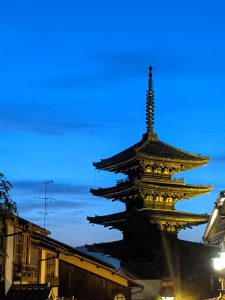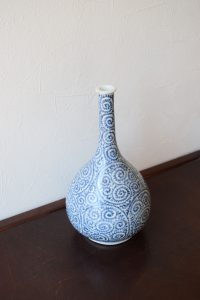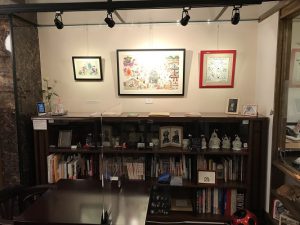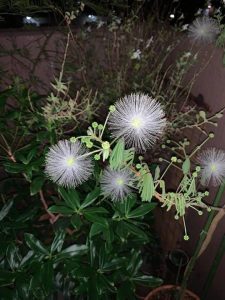みなさまこんにちは、スタッフYでございます。
今回は、先日の修学院の続編でありますが、後から見直しますと写真の出来が今一つが多く、この感動をお伝えすることができるのか…と、思いつつ本日は綴ってまいりたいと思います。
修学院、もとは10世紀後半に修学院という寺が建立したことが名前の由来でありますが、その後明暦元年から2年(1655~1656年)にかけて御水尾上皇によって造営工事がなされた山荘であります。
その後幾度の造営を繰り返しますが、昭和39年には各離宮の間にありました8万㎡に及ぶ水田畑地を買い上げて附属農地とし、景観保持の備えにも万全を期して現在の修学院離宮をなしております。
さてさて、中に入ってまいりましょう。
上・中・下の三つの離宮に分かれておりますが、それぞれの離宮にはいるところに門扉がございます。それぞれの離宮は少々はなれておりまして、先ほどお伝えした水田畑地を抜けながら訪れるようになっております。
まずは寿月観のございます下離宮から。
まずは、板戸の御幸門(上段写真)から下離宮に入るのですが、そこをくぐりますともはや別世界。まず、感動。御幸門と相対する位置にある東門から出ると視界が大きく開け,田圃の向うに比叡の霊峰から東山,北山の山並みが一望。比叡山も借景にしっかりはいっております。

さらに中門を潜り、眼前に庭園がひらけ、緩やかな石段の上には寿月観の玄関「御輿寄」が。
袖形灯籠,朝鮮灯籠等を配した苑路を上ると寿月観は、大変おとなしい佇まい。文政年間に旧規のとおりに再興されたものでありますが、一の間に掛かる「寿月観」の扁額は後水尾上皇の宸筆だそうです。

建物は柿葺入母屋数寄屋風造りでして、どこを拝見しましても、大変手入れされております。
こちらは、三の間の襖絵。筆者は岡本豊彦であります。

襖絵からもわかるように、決して華美ではないのですが、当時は、今はない彎曲閣とともに相当なもてなしの出来る設備は備わっていたようです。
そして、水田畑地をぬけて中離宮へ向かいます。
この移動の空間もまさに別世界でして、人や車が行き交うこともなくこの空間にいるのは定員の見学者のみ。私もですが、みなさんこの空間を少しでも感じ取ろうと大変静かあります。
広い敷地の中をゆったりとした清々しい風を感じながら中離宮へ。

そして楽只軒へ。

楽只軒はかなり古い建物で,現在の林丘寺にある扁額の年紀銘から推察すると寛文8年(1668年)かその前年に創建されたものと思われます。南側には庭に面して広縁を設け,床を低くとり庭との一体感を深めておりまして、特別な技巧は凝らしていませんが,簡素な中にも趣があります。
中を覗きますと、当時の配色としては斬新的な色彩の市松模様の柄の襖と一間半の飾り棚が,まず目に入ります。互い違いに配された大小五枚の棚板がいかにも霞がたなびいているように見えることから「霞棚」と呼ばれ、桂離宮の桂棚、三宝院の醍醐棚とともに天下の三棚と称されているようです。違い棚にも「三大○○」があったのか…。
今まで日本に暮らして数十年ですが、床の間や違い棚などに注視したことなどなかったわけでして、こうして改まって拝見いたしたしますと、この限られた空間に季節や家人の趣味などさまざまな情報や世界感を表現できるスペースを作るなんて、あらためて斬新さを感じたりも致しました。

また、祇園祭の鉾の絵を描いた杉戸の筆者は住吉具慶と言われ、こちらの鯉の絵の筆者は不祥でありますが、鯉の絵の網だけは円山応挙の筆と伝えられております。鯉が逃げ出さないように、網を夜に描き加えたとの逸話が。
そして、いよいよ上離宮。
下離宮へいったん戻り。田畑の中の高い刈込みの間をぬって急な石段を上ってゆきます。両側の刈込みで視界をさえぎられ,石段がカーブしているので上りつめたところに何が待ちうけているのか見当もつかない中、頂上に隣雲亭が。

ふり向けば眼下に浴龍池が見え、その向こうには洛北の山々が見渡せ、すでに離宮が山々の借景になじんでいることを感じとれます。自分もこの借景の中にすっぽり入りこんでいるんでしょうね。かなり登ってきておりますので、ずっと左手にの方には洛中の街並みがひろがり,かなりその向うに西山の峰々も。晴れておりますと大阪のあべのハルカスまで見通せるそうです。
ここからの眺望、これは作られたものなのかたまたまそのような風景があったものなのかは存じませんが当時の後水尾上皇もさぞご満悦だったでしょうね。
そして、木橋の楓橋を渡ると中島のいよいよ頂上に、宝形造りの茶屋窮邃亭が。文政年間に修復はあったものの創建当時の建物で現存する唯一のものなのですが、こちらも本当にシンプル。中は、こんな感じ。

「窮邃」の扁額は後水尾上皇の宸筆であり、十八畳と附属の水屋の一間からなるのですが、一隅に直角に折れて畳一枚高くした上段を設け,上段西側いっぱいに低く一枚板を渡して御肘寄としております。この建物の中からの景色を眺めてみたいものですが、さやさやと通りぬける畳の上にお布団を敷いてお昼寝したいとも誰かきっと思ったのでは。(失礼いたしました)


そして、浴龍池をぐるりと回りながら今まで訪れた山荘を振り返ります。浴龍池には楓橋や土橋、紅美谷や三保ヶ島など人の手でつくられた庭などの物静かでいて周りの景色と馴染んだ景観と、大刈込みの上に位置するはっきりと作られた浜辺の西浜など明るくのびのびとした風景などが対照的に展開している印象。さりげなく池を配しておりますが、よくよく考えますとこれってかなり大変な工事だったのではないでしょうか。ですが、いたってさりげない。
とまあ、駆け抜けて参りました修学院離宮。どこを切り取っても洛北や比叡の山々がこの広大な離宮の背景を描いており、それでいてその中に、離宮や池そして田畑はあくまでもさりげなくたたずんでおりました。
贅沢にもそんなさりげない風景の中に入りこめ、借景の極みを心行くまで堪能できた5月の青天にも感謝であります。
皆様も、一度は修学院離宮訪れてみてくださいませ。
それでは、ごきげんよう。
Hello everyone, this is Staff Y.
This time, it is a sequel to Shugakuin the other day, but if you review it later, there are many photos that are not good enough, and I would like to spell it out today, wondering if I can convey this impression.
Shugakuin, originally a temple called Shugakuin, was built in the latter half of the 10th century, but it was a mountain cottage that was built by Emperor Emeritus Mimizuo from the first year of the Meireki to the second year (1655-1656). I have.
After that, the construction was repeated many times, but in 1964, the paddy field of 80,000 m2, which was located between each palace, was purchased and used as an attached farmland, and the current Shugakuin palace was opened to prepare for the preservation of the landscape. I am doing it.
Well, let’s go inside.
It is divided into three palace, upper, middle and lower, and there is a gate at each palace. Each palace is a little far away, and you can visit it while passing through the paddy fields I mentioned earlier.
First of all, from the lower palace where you can see the view of Suzuki.
First of all, you will enter the Shimo Rikyu from the Miyuki Gate of Itado (upper photo), but when you pass through it, you will be in another world. First of all, I was impressed. When you exit from the east gate, which is located opposite the Miyuki gate, you can see a wide field of view, and you can see the mountains of Higashiyama and Kitayama from the Hiei sacred mountain beyond the rice fields. Mt. Hiei is also in the background.
Further down the middle gate, a garden opens in front of you, and on the gentle stone steps is the entrance to the view of the Suigetsu, “Mikoshi Yori”.
When you go up the garden road with sleeve-shaped lanterns, Korean lanterns, etc., the view of Sugetsu is very quiet. It was revived according to the old regulations during the Bunsei era, but it is said that the flat amount of “Suzukikan” that hangs in one hour is written by Emperor Gomizuo.
The building is a persimmon-roofed main building with a sukiya-style structure, and it is in great condition no matter where you look.
This is a fusuma painting of Sanma. The author is Toyohiko Okamoto.
As you can see from the fusuma paintings, it is by no means gorgeous, but at that time, it seems that it was equipped with facilities that could provide considerable hospitality along with the now-defunct Kyokukaku.
Then, go through the paddy fields to the Nakarikyu.
This space of movement is also a different world, and only a limited number of visitors are in this space without people and cars coming and going. As for me, everyone is very quiet to feel this space as much as possible.
Go to Nakarikyu while feeling the refreshing breeze in the large site.
And then to Rakudaiken.
Rakudaiken is a fairly old building, and it seems that it was built in Kanbun 8 (1668) or the year before, judging from the biane chronological inscription in the present Hayashiokaji Temple. On the south side, a wide rim facing the garden is set up, and the floor is lowered to deepen the sense of unity with the garden.
If you look inside, you will first see the fusuma sliding doors with a checkered pattern and a half-length display shelf, which are the novel colors of the time. It is called “Kasumi shelf” because the five large and small shelves arranged alternately are called “Kasumi shelf” because it looks like the haze is fluttering. And it seems. Was there “three major XX” on the difference shelf?
I have lived in Japan for several decades, but I have never looked at the alcove or the different shelves, so when I look at it again, there are various seasons and hobbies of the family in this limited space. I felt a new sense of novelty in creating a space that can express new information and a sense of the world.
In addition, the author of Sugito who drew the picture of the halberd of Gion Matsuri is said to be Gukei Sumiyoshi, and the author of this carp picture is unscrupulous, but it is said that only the net of the carp picture is the brush of Maruyama Okyo. .. There is an anecdote that a net was added at night to prevent the carp from escaping.
And finally, the upper palace.
Return to Shimo Rikyu. Go up the steep stone steps through the high pruning in the fields. The view is obstructed by the pruning on both sides, and the stone steps are curved, so I have no idea what is waiting for me when I climb up, but next door is at the top.
If you turn around, you can see Yuryu Pond below, and beyond that you can see the mountains of Rakuhoku, and you can feel that the palace is already familiar with the scenery of the mountains. I’m sure I’m completely in the background. I’ve climbed quite a bit, so the cityscape of Rakuchu spreads out to the left, and the peaks of Nishiyama are far beyond that. When it’s sunny, you can see Abeno Harukas in Osaka.
I don’t know if the view from here was made or if it happened to have such a landscape, but Emperor Gomizuo at that time would have been very happy.
Then, when you cross the Kaede Bridge of the wooden bridge, you will finally find the treasure-shaped teahouse Kakutei at the top of Nakajima. Although it was restored during the Bunsei era, it is the only existing building at the time of its construction, but this is also really simple. Inside is like this.
The flat frame of “Kanjou” is written by Emperor Gomizuo and consists of 18 tatami mats and a room of the attached Mizuya. I handed a low plate to the emeritus. I’d like to see the scenery from inside this building, but I’m sure someone would have wanted to take a nap by laying a futon on a tatami mat that passes through the pods. (excuse me)
Then, while going around Yuryu Pond, we look back on the mountain cottages we have visited so far. In Yuryu Pond, there is a quiet and familiar landscape such as Kaede Bridge, Dobashi, Benimiya, Mihogashima and other gardens made by humans, and a clearly made beach located on the large pruning. The impression is that the bright and laid-back landscapes such as Nishihama are contrasting. The ponds are arranged casually, but if you think about it carefully, it might have been a lot of work. However, it’s very casual.
Well, I ran through the Shugakuin Imperial Villa. No matter where you cut it, the mountains of Rakuhoku and Hiei drew the background of this vast palace, yet the palace, ponds and fields stood casually in it.
I am also grateful to the blue sky in May, where I was able to lavishly enter into such a casual landscape and enjoy the extremes of the scenery to my heart’s content.
*********************
爽やかなお天気が続いておりますね。お片付けなどされてる方もおおいのではないでしょうか。
風光舎では、古美術品や骨董品の他にも絵画や宝石、趣味のお品など様々なジャンルのものを買受しております。
お片付けをされていて、こういうものでもいいのかしらと迷われているものでも、どうぞお気軽にご相談下さいませ。
また風光舎は、出張買取も強化しております。
ご近所はもちろん、愛知県内、岐阜県、三重県その他の県へも出張いたします。
まずは、お電話お待ちしております。
愛知県名古屋市千種区・骨董 買取
『古美術 風光舎 名古屋店』
TEL052(734)8444
10:00-17:00 OPEN
































